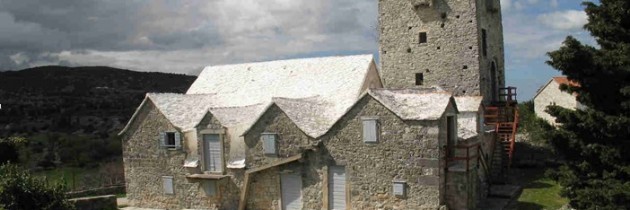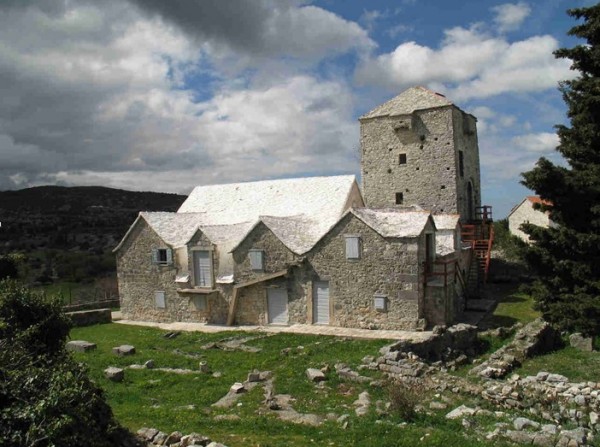Muzej otoka Brača
 Radno vrijeme muzeja / working hours:
Radno vrijeme muzeja / working hours:
Svaki dan / every day:
8.00 – 20.00 sati
Ulaz / entrance fee
Odrasli / adults: 15 kuna
djeca do 14 godina / children up to 14 years: 5 kuna
e- mail: centar.za.kulturu.brac@st.t-com.hr
tel/ phone: +385( 21) 637 092
+385 (91)6370920
MUZEJ OTOKA BRAČA, ŠKRIP. Muzej otoka Brača smješten je u Škripu, najstarijem naselju na otoku u kojemu preko pet tisuća godina traje život o čemu govore i mnogobrojni spomenici. Ime Škripa potječe od latinske imenice scrupus, koja znači «oštro, golemo kamenje», kakvo je bilo ovdje, u zaleđu rimskih kamenoloma. U muzejskom sklopu ambijentalnih kuća, koje dijelom zatvaraju ilirske zidine, rimski mauzolej i hrvatski tvrdalj, smješten je bogat lapidarij rimskih, kasnoantičkih i ranosrednjovjekovnih spomenika graditeljstva i skulpture, među kojima se ističu Herkulov lik, nalazi u Mirju i drugdje, te odljev Povaljskoga praga. U ostalim dvoranama nalazi se zanimljiva etnografska zbirka ovog poljoprivrednog, stočarskog i kamenarskog otoka, te vrijedni predmeti kućnog namještaja. Iznad rimskog mauzoleja strši visoko kula Radojković podignuta u 16. stoljeću za mletačko-turskih ratova. U kuli je uređena bogata zbirka fotografija, oružja i dokumenata antifašističkog pokreta na otoku iz Drugog svjetskog rata.
ISLAND OF BRAČ MUSEUM, ŠKRIP. The island’s regional museum has made a perfect choice by taking Škrip for its location, a monument itself, being the oldest settlement on the island with an abundance of cultural monuments. The name Škrip originates from the Latin word scrupus, which denotes huge sharp stones that in those times were to be found at the back of Roman quarries. Among the houses that partly enclose the Illyrian buildings, the Roman mausoleum and the Croatian stronghold, there is a rich stone collection consisting of Roman, Late Antiquity and Early Medieval monuments and sculptures. The most prominent of these are the image of Hercules, the findings from Mirje and elsewhere and the copy of the Povlja lintel. Interesting ethnographic artefacts of this island are immersed in its agricultural, sheep-breeding and stone-masonry tradition, as well as in the valuable examples of its furniture which are to be found in the halls on the first floor. Above the Roman mausoleum is the projecting Radojković tower (kula Radojković) which was built in the 16th century, during the Venetian-Turkish wars. Within the tower a rich collection of photographs, weapons and documents from the World War II depicting the history of the antifascist movement on island is displayed.
MUSÉE DE L’ILE DE BRAČ, ŠKRIP. Le Musée de l’île de Brač se trouve à Škrip, le plus ancien village de l’île, dans lequel la vie perdure depuis plus de cinq milles ans, comme en témoignent les innombrables monuments. Le nom Škrip découle du latin scrupus, qui signifie „pierre immense et tranchante“, comme celles que l’on trouvait ici aux abords des carrières romaines. Dans le périmètre des maisons pittoresques jouxtant le musée, qui sont entourées partiellement de fortifications illyriennes, d’un mausoléee romain et d’un fortin croate, se niche un riche musée lapidaire recelant des sculptures et des oeuvres architecturales romaines de la basse antiquité et du haut moyen-âge, parmi lesquelles se détachent une statue d’Hercule, des découvertes de Mirj et d’ailleurs, ainsi qu’un coulage du „pas de Povalj“. Dans les salles restantes se trouvent une intéressante collection etnographique caractéristique de cette île rocailleuse d’agriculture et d’élevage, ainsi que de précieuces pièces de mobilier. Au dessus du mausolée se dresse la haute tour Radojković, élevée au 16e siècle lors des guerres entre l’empire ottoman et Venise. L’intérieur de la tour est paré d’une riche collection de photos, d’armes et de documents évoquant le mouvement antifasciste de l’île pendant la seconde guerre mondiale.
MUSEUM DER INSEL BRAČ, ŠKRIP. Das Museum der Insel Brač liegt in Škrip, der ältesten Siedlung auf der Insel, in welcher über fünftausend Jahre lang das Leben dauert, wovon auch zahlreiche Denkmäler zeugen. Der Name von Škrip stammt vom lateinischen Nomen scrupus, was «scharfes, gigantisches Gestein» bedeutet und solches gab es hier, im Hinterland des römischen Steinbruchs. Im Museumsgefüge ambienteller Häuser, welche teilweise von illyrischem Gemäuer, römischen Mausolen und kroatischen Festungen abgeschlossen sind, ist das reiche Lapidarium an römischen, spätantiken und frühmittelalterlichen Denkmälern der Architektur und Skulpturen untergebracht, unter welchen sich die Gestalt des Herkules, Funde aus Mirja und von anderswo, sowie der Ausfluss der Schwelle Povaljsko hervorheben. In den übrigen Sälen befindet sich eine interessante ethnographische Sammlung dieser landwirtschaftlichen, Viehzucht- und Steinbruchinsel, sowie wertvolle Gegenstände häuslichen Mobiliars. Über dem römischen Mausoleum ragt der hohe Turm Radojković hervor, welcher im 16. Jahrhundert während der venezianisch-türkischen Kriege errichtet wurde. Im Turm ist eine reiche Sammlung an Fotografien, Waffen und Dokumenten der antifaschistischen Bewegung auf der Insel aus dem Zweiten Weltkrieg untergebracht.
MUSEO DELL’ISOLA DI BRAČ, ŠKRIP. Il museo regionale dell’isola, stabilendo a Škrip la propria sede, ha compiuto una scelta davvero eccellente; un luogo che costituisce un monumento già da sé, trattandosi del più antico insediamento sull’isola, con un ricco patrimonio culturale. Il nome Škrip deriva dal latino scrupus, che si riferisce alle enormi pietre aguzze ritrovate nei pressi delle cave romane. Tra le abitazioni che in parte circondano gli edifici illirici, il mausoleo romano e la roccaforte croata, si può ammirare una ricca collezione di monumenti e sculture in pietra, risalenti al periodo romano, tardo antico e altomedievale. Tra di essi spiccano l’immagine di Ercole, i ritrovamenti di Mirje e dintorni, e una copia dell‘architrave di Povlja. Gli interessanti manufatti e i pregevoli esempi di suppellettili esposti nelle sale al primo piano, oltre ad avere una certa rilevanza da un punto di vista etnografico, rimandano alle tradizioni locali legate all’agricoltura, alla pastorizia e all’estrazione della pietra. Sopra il mausoleo romano spicca la torre Radojković (kula Radojković), costruita nel XVI secolo, durante le guerre tra Veneziani e Turchi. All’interno della torre è custodita una ricca collezione di fotografie, armi e documenti risalenti alla Seconda Guerra Mondiale, a testimonianza della storia del movimento antifascista sull’isola.
MUZEUM OSTROVA BRAČ, ŠKRIP. Muzeum ostrova Brač se nalézá ve Škripu, v nejstarší osadě na ostrově, která je obydlena již více než pět tisíc let, o čemž svědčí i mnohačetné památky. Název Škripa pochází z latinského slova scrupus, které znamená “ostré, ohromné kamení”, které bylo zde – za římskými kamenolomy. V muzejním komplexu původních domů, které jsou částečně ohrazeny ilyrskými hradbami, římským mauzoleem a chorvatskou pevností, se nachází bohaté lapidárium římských, pozdně antických a raně středověkých památek stavitelství a skulptury, z nichž je nutno zmínit sochu Herkula, nacházející se v Mirji i jinde a odlitek Povaljského prahu. V ostatních sálech se nachází zajímavá etnografická sbírka tohoto zemědělského, dobytkářského a kamenického ostrova a vzácné předměty domácího nábytku. Nad římským mauzoleem se tyčí vysoká věž Radojković, postavena v 16.stol. během benátsko-tureckých válek. Ve věži je zřízena bohatá sbírka fotografií, zbraní a dokumentů antifašistického hnutí na ostrově z druhé světové války.




